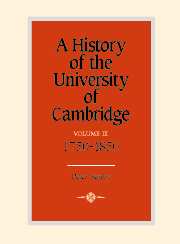Book contents
- Frontmatter
- Contents
- List of illustrations
- General Editor's preface
- Acknowledgements
- List of abbreviations
- Introduction
- 1 Townscape and university: topographical change
- 2 The university: its constitution, personnel, and tasks
- 3 Colleges: buildings, masters, and fellows
- 4 Colleges: tutors, bursars, and money
- 5 Mathematics, law, and medicine
- 6 Science and other studies
- 7 Religion in the university: its rituals and significance
- 8 The Orthodox and Latitudinarian traditions, 1700–1800
- 9 Cambridge religion 1780–1840: Evangelicalism
- 10 Cambridge religion: the mid-Victorian years
- 11 The university as a political institution, 1750–1815
- 12 The background to university reform, 1830–1850
- 13 Cambridge and reform, 1815–1870
- 14 The Graham Commission and its aftermath
- 15 The undergraduate experience, I: Philip Yorke and the Wordsworths
- 16 The undergraduate experience, II: Charles Astor Bristed and William Everett
- 17 The undergraduate experience, III: William Thomson
- 18 Games for gownsmen: walking, athletics, boating, and ball games
- 19 Leisure for town and gown: music, debating, and drama
- Appendices
- Bibliography
- Index
12 - The background to university reform, 1830–1850
Published online by Cambridge University Press: 05 April 2012
- Frontmatter
- Contents
- List of illustrations
- General Editor's preface
- Acknowledgements
- List of abbreviations
- Introduction
- 1 Townscape and university: topographical change
- 2 The university: its constitution, personnel, and tasks
- 3 Colleges: buildings, masters, and fellows
- 4 Colleges: tutors, bursars, and money
- 5 Mathematics, law, and medicine
- 6 Science and other studies
- 7 Religion in the university: its rituals and significance
- 8 The Orthodox and Latitudinarian traditions, 1700–1800
- 9 Cambridge religion 1780–1840: Evangelicalism
- 10 Cambridge religion: the mid-Victorian years
- 11 The university as a political institution, 1750–1815
- 12 The background to university reform, 1830–1850
- 13 Cambridge and reform, 1815–1870
- 14 The Graham Commission and its aftermath
- 15 The undergraduate experience, I: Philip Yorke and the Wordsworths
- 16 The undergraduate experience, II: Charles Astor Bristed and William Everett
- 17 The undergraduate experience, III: William Thomson
- 18 Games for gownsmen: walking, athletics, boating, and ball games
- 19 Leisure for town and gown: music, debating, and drama
- Appendices
- Bibliography
- Index
Summary
THE UNIVERSITIES OF THE BRITISH ISLES
Few Cambridge writers mentioned, or at all events valued, the other universities in the British Isles – apart from Oxford and perhaps Trinity College Dublin. But the ancient universities of Scotland, and new foundations in England and Ireland, were prominent in national discourse on the purposes of education and the best ways to organise it. They offered models that contrasted with Cambridge's collegiate tuition and narrow honours curriculum; at least compelling Cambridge to justify its ways, they excited debate and influenced its terms. Though their effect upon the reform movement is hard to measure, it was no less important for that.
The ancient universities of Scotland were in some fundamental ways quite different from Oxford and Cambridge. There were four (or strictly speaking five) universities, in Edinburgh, Glasgow, St Andrews, and Aberdeen. They were ‘non-collegiate’ in structure, apart from St Andrews, whose two colleges did not possess the endowments and power familiar in Cambridge. While the medical schools of Oxford and Cambridge were moribund in the eighteenth century, those in Edinburgh and Glasgow were famous for combining advanced scientific instruction with clinical experience in local hospitals. And while Cambridge's few outstanding contributions to scholarship were in the traditional field of classics, Scotland's intellectual adventurousness was famous; some leading figures in the European Enlightenment were professors, most notably Adam Smith, who was a professor at Glasgow.
- Type
- Chapter
- Information
- A History of the University of Cambridge , pp. 423 - 471Publisher: Cambridge University PressPrint publication year: 1997

